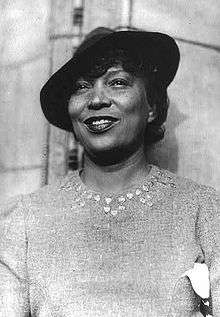Mules and Men
Mules and Men is a 1935 autoethnographical collection of African-American folklore collected and written by anthropologist Zora Neale Hurston.[1] The book explores stories she collected in two trips: one in Eatonville and Polk County, Florida, and one in New Orleans.[1][2][3] Hurston's decision to focus her research on Florida came from a desire to record the cross-section of black traditions in the state. In her introduction to Mules and Men, she wrote, "Florida is a place that draws people—white people from all over the world, and Negroes from every Southern state surely and some from the North and West".[4] Hurston documented 70 folktales during the Florida trip, while the New Orleans trip yielded a number of stories about Marie Laveau and other voodoo traditions.[1]

The book embraces both her own re-immersion in the folklore of her childhood, and a desire to document those traditions as part of the emergent anthropological sciences.[5][6] Subsequently, the book has been described as an important text for the canonization of Hurston in both American and African-American literature, and in developing fields such as ethnography and critical race theory.[2][7][8]
Reception
The work has a significant legacy in African-American literature and anthropology. Franz Boas, her academic mentor and the writer of the book's preface, and the father of American anthropology, wrote that "It is the great merit of Miss Hurston's work that she entered into the homely life of the southern Negro" with the "charm of a loveable personality and of a revealing style."[1]
References
- "Plot Summaries". Zora Hurston Archive. University of Central Florida Center for Humanities and Digital Research. Retrieved April 5, 2016.
- Hern, Graciela (1993). "Multiple Mediations in Zora Neale Hurston's Mules and Men" (PDF). Critique of Anthropology. 13 (4).
- Brown, Lois (2006). Encyclopedia of the Harlem Literary Renaissance. Facts on File. pp. 262.
- Hurston, Zora Neale (1935). Mules and Men. J.B. Lippincott Company. p. 17.
- Lin, Jung-Hsien (2013). "Between Literature and Science: Inscribing Zora Neale Hurston's Mules and Men in the Post-human Condition". LUX: A Journal of Transdisciplinary Writing and Research from Claremont Graduate University. 3 (1).
- Meisenhelder, Susan (1996-01-01). "Conflict and Resistance in Zora Neale Hurston's Mules and Men". The Journal of American Folklore. 109 (433): 267–288. doi:10.2307/541531. JSTOR 541531.
- Dorst, John (1987-08-01). "Rereading Mules and Men: Toward the Death of the Ethnographer". Cultural Anthropology. 2 (3): 305–318. doi:10.1525/can.1987.2.3.02a00030. ISSN 1548-1360.
- Wall, Cheryl A. (1989-01-01). "Mules and Men and Women: Zora Neale Hurston's Strategies of Narration and Visions of Female Empowerment". Black American Literature Forum. 23 (4): 661–680. doi:10.2307/2904095. JSTOR 2904095.